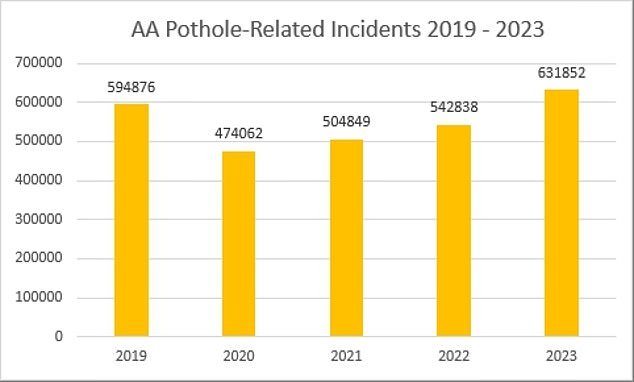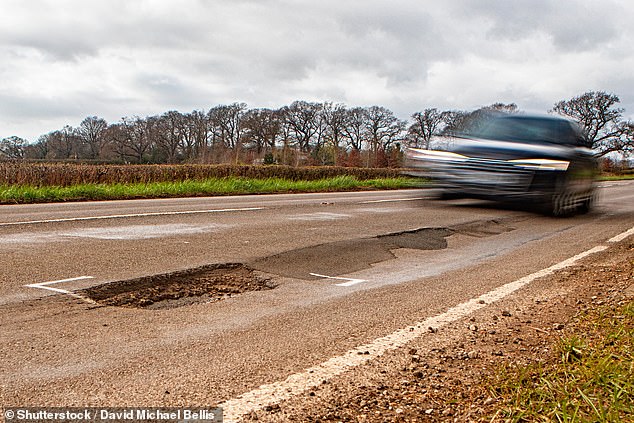Table of Contents
The AA has attended to almost half a million pothole-related breakdowns in the first nine months of 2024, and Britain’s growing road epidemic is set to worsen as a result of heavy rain in recent weeks.
The emergency assistance provider alone has responded to 480,000 calls from drivers stranded after encountering potholes between January and September.
Last month, its patrols attended 50,244 incidents, 4 percent more year-on-year and the highest recorded since 2017.
With the crisis expected to worsen in the remaining three calendar months following floods that hit the entire country last month, the automotive group has called on the Government to increase funding to permanently repair roads rather than provide piecemeal solutions. ineffective.
The AA says it has seen a 4% increase in pothole-related vehicle breakdowns in the first 9 months of the year, with the worst to come as temperatures begin to drop following a spate of wet weather.
The AA, Britain’s biggest breakdown provider, says it has responded to 479,656 breakdowns caused by potholes so far this year.
This is 10,000 more than in the same period in 2023, according to its monthly pothole index.
The latest update suggests that 2024 is on track to surpass last year’s total number of calls, which was 631,852, which was reported to be a five-year high.
With the RAC, the second largest patrol, also dealing with around 8,000 pothole damage calls per quarter, it is likely that more than 500,000 UK drivers have fallen victim to the poor state of the country’s road surfaces.
And there are fears that the recent bad weather in Britain will exacerbate what is already a major problem.
After weeks of flooding, The AA says potholes disguise themselves as they fill with water.
Falling temperatures and increased rainfall will also increase the severity of potholes, causing damage to tyres, wheels, steering and suspension for those unable to avoid them.
Even more vulnerable are cyclists – the AA says up to 118 have died in the last four years due to potholes.
In March, the The Asphalt Industry Alliance (AIA) said it would take local authorities 11 years to fix all bad roads in England and Wales, compared to nine years in 2022, and cost a staggering £16.43 billion.
The AIA’s Annual Local Authority Road Maintenance Report (ALARM) also found that there were 8,000 fewer miles of roads rated “good” compared to last year, a 4 percent drop.
The RAC had previously estimated there were around one million potholes across the UK at any one time, while a staggering 2.2 million will be fixed in 2023.
Transport Secretary Louise Haigh had promised during Labour’s general election campaign to redirect £8.3bn of available funding from the scrapped HS2 budget to tackle the pothole epidemic and “provide councils with long-term funding agreements so that roads are fixed for the long term.
With the autumn budget approaching this month, the AA has teamed up with companies including British Cycling, the National Motorcyclists Council, road safety group IAM RoadSmart and JCB, which has developed specialist repair vehicle PotholePro, to form what called the ‘Bump’. Association’.
He warned that road users are “fed up” with current conditions and called for a new wave of funding and guidance for local authorities to carry out necessary repairs and help them maintain good condition.
“(The government) has the opportunity to take a step forward in the spiral of decline by adopting and championing measures to permanently solve the problem, rather than the piecemeal approach of the past,” said AA president Edmund King.

Last month, Haigh declared war on potholes and vowed to use cutting-edge repair technology to combat the “plague”.
During a visit to Blackpool, the Transport Secretary met with highways workers and councilors to learn about high-definition imaging technology.
The city’s Project Amber program uses an advanced imaging system that takes high-definition photographs of roads to detect potholes and collect data on areas most in need of repair.
It is hoped that similar systems can be replicated throughout the country.
Mrs Haigh said: “For too long this country has suffered from a plague of potholes.
‘Blackpool Council is already doing fantastic work to make the most of new technology to fix potholes faster.
“This should be a model for all communities to learn from and help get the roads their drivers deserve.”
Some links in this article may be affiliate links. If you click on them, we may earn a small commission. That helps us fund This Is Money and keep it free to use. We do not write articles to promote products. We do not allow any commercial relationship to affect our editorial independence.


